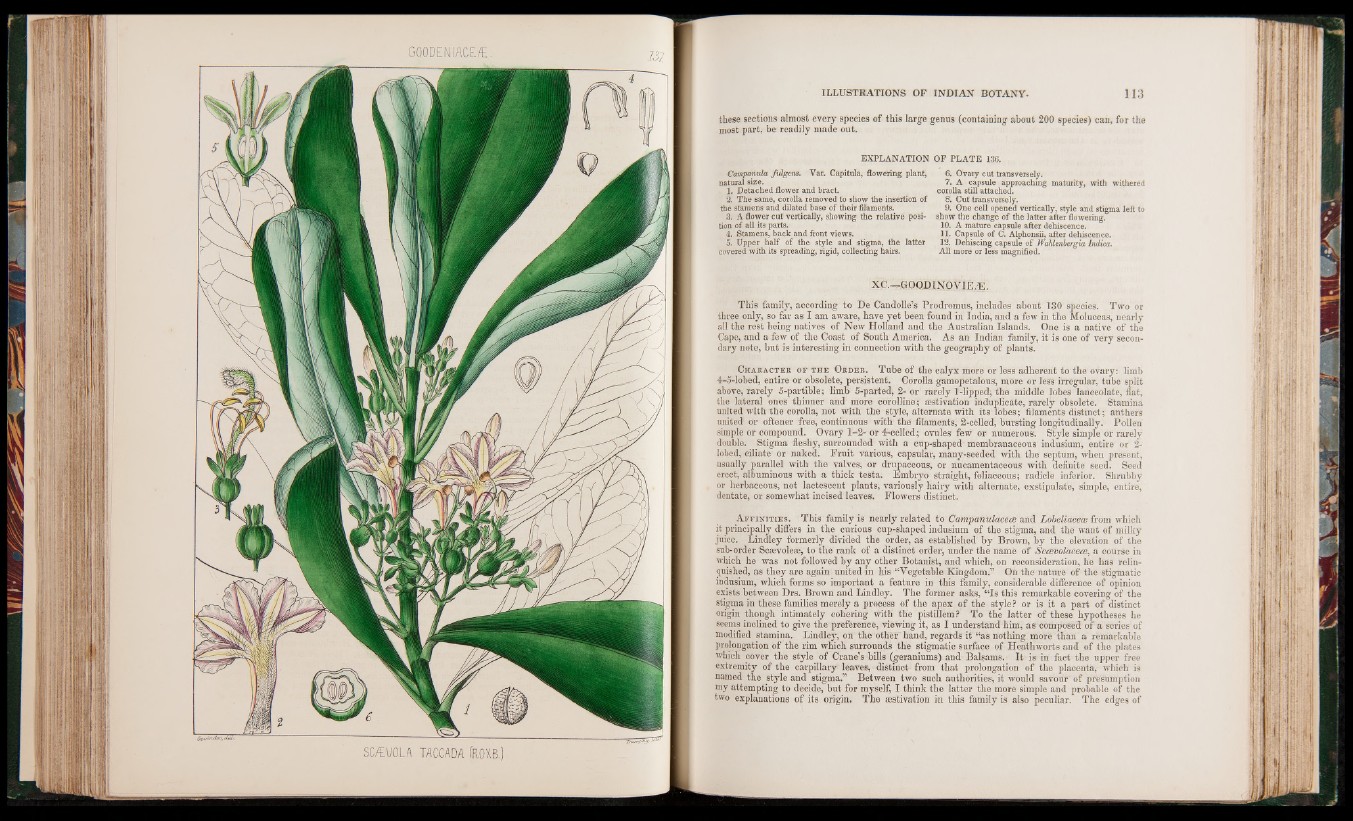
GOODENIACEÆ,
SCÆVOLA TACCADA (fiOXB.j
these sections almost every species of this large genus (containing about 200 species) can, for the
most part, be readily made out.
EXPLANATION OF PLATE 136.
Campanula fulgens. Var. Capitula, flowering plant,
natural size.
1. Detached flower and bract
2. The same, corolla removed to show the insertion of
the stamens and dilated base of their filaments.
3. A flower cut vertically, showing the relative position
of all its parts.
4. Stamens, back and front views.
5. Upper half of the style and stigma, the latter
covered with its spreading, rigid, collecting hairs.
6. Ovary cut transversely.
7. A capsule approaching maturity, with withered
corolla still attached.
8. Cut transversely.
9. One cell opened vertically, style and stigma left to
show the change of the latter after flowering.
10. A mature capsule after dehiscence.
11. Capsule of C. Alphonsii, after dehiscence.
12. Dehiscing capsule of WaMmbergia Indica.
All more or less magnified.
XC.-^GOODINOVIEiE.
This family, according to De Candolle’s Prodromus, includes about 130 species. Two or
three only, so far as I am aware, have yet been found in India, and a few in the Moluccas, nearly
all the rest being natives of New Holland and the Australian Islands. One is a native of the
Cape, and a few of the Coast of South America. As an Indian family, it is one of very secondary
nöte, but is interesting in connection with the geography of plants.
Character of the Order. Tube of the calyx more or less adherent to the ovary: limb
4-5-lobed, entire or obsolete, persistent. Corolla gamopetalous, more or less irregular, tube split
above, rarely 5-partible; limb 5-parted, 2- or rarely 1-lipped; the middle lobes lanceolate, flat,
the lateral ones thinner and more corolline; aestivation induplicate, rarely obsolete. Stamina
united with the corolla, not with the style, alternate with its lobes; filaments distinct; anthers
united or oftener free, continuous with the filaments, 2-celled, bursting longitudinally. Pollen
simple or compound. Ovary 1-2- or 4-celled; ovules- few or numerous. Style simple or rarely
double. Stigma fleshy, surrounded with a cup-shaped membranaceous indusium, entire or 2-
lobed, ciliate or naked. Fruit various, capsular, many-seeded with the septum, when present,
usually parallel with the valves, or drupaceous, or nucamentaceous with definite seed. Seed
erect, albuminous with a thick testa. Embryo straight, foliaceous; radicle inferior. Shrubby
or herbaceous, not lactescent plants, variously hairy with alternate, exstipulate, simple, entire,
dentate, or somewhat incised leaves. Flowers distinct.
Affinities. This family is nearly related to CampanulctcecB and Loheliacece from which
it principally differs in the curious cup-shaped indusium of the stigma, and the want of milky
juice. Lindley formerly divided the order, as established by Brown, by the elevation of the
sub-order Scaevoleae, to the rank of a distinct order, under the name of Sbavolacece, a course in
which he was not followed by any other Botanist, and which, on reconsideration, he has relinquished,
as they are again united in his “Vegetable Kingdom*” On the nature of the stigmatic
indusium, which forms so important a feature in this family, considerable difference of opinion
exists between Drs. Brown and Lindley. The former asks, “Is this remarkable covering of the
stigma in these families merely a process of the apex of the style? or is it a part of distinct
origin though intimately cohering with the pistillém? To the latter of these hypotheses he
seems inclined to give the preference, viewing it, as I understand him, as composed of a series of
modified stamina. Lindley, on the other hand, regards it “as nothing more than a remarkable
prolongation of the rim which surrounds the stigmatic surface of Heathworts and of the plates
which cover the style of Crane’s bills (geraniums) and Balsams. I t is in fact the upper free
extremity of the carpillary leaves, distinct from that prolongation of the placenta, which is
named the style and stigma.” Between two such authorities, it would savour of presumption
my attempting to decide, but for myself, I think the latter the more simple and probable of the
two explanations of its origin. The aestivation in this family is also peculiar. The edges of